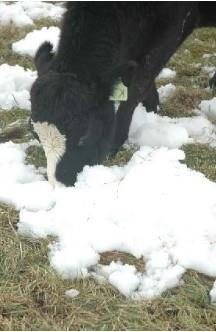By Chris Teutsch
Feeding hay during the winter months is the single highest expense for cow-calf producers in transition zone states like Kentucky. In many cases it can make up more than 60% of the total cow-calf budget. While dry hay is the cornerstone of most winter-feeding programs, grazing stockpiled cool-season grasses in late fall and winter can reduce feed costs by more than 50% per day per cow. The following tips will help to optimize your stockpiling program.

Grazing stockpiled cool-season grasses in late fall and winter can reduce feed costs by more than 50% per day per cow.
Choose a strong tall fescue sod in a field that is well drained. To get the maximum yield response to nitrogen applications you will need a healthy stand of tall fescue. Choosing a field that is well-drained will help to ensure that the stockpile can be grazed with minimal pugging damage during the wet winter months.
Clip or graze pastures that will be stockpiled to 3-4 inches prior to applying nitrogen. Clipping pastures removes old growth and increases the forage quality of the stockpiled grass.
Apply 60-80 lb of nitrogen per acre in mid to late August. Applying nitrogen too early can stimulate summer annual weed growth, while applying nitrogen too late decreases dry matter yield.
Allow growth to accumulate until mid-December before grazing. If limited grazing is available, feed hay during this accumulation period rather than the winter months.
Graze stockpiled pastures that contain legumes first. Legumes deteriorate at faster rate than grass and should be grazed first to minimize losses.
Strip graze tall fescue to maximize grazing days. Allocating only enough stockpiled grass for 2-3 days will increase grazing days per acre by more than 30%.
Frost seed legumes on grazed areas. Closely grazed stockpile provides an excellent opportunity to establish legumes in grass dominated pastures. Broadcasting the seed as the pasture is being grazed can enhance soil-seed contact and increase overseeding success.
Source : osu.edu